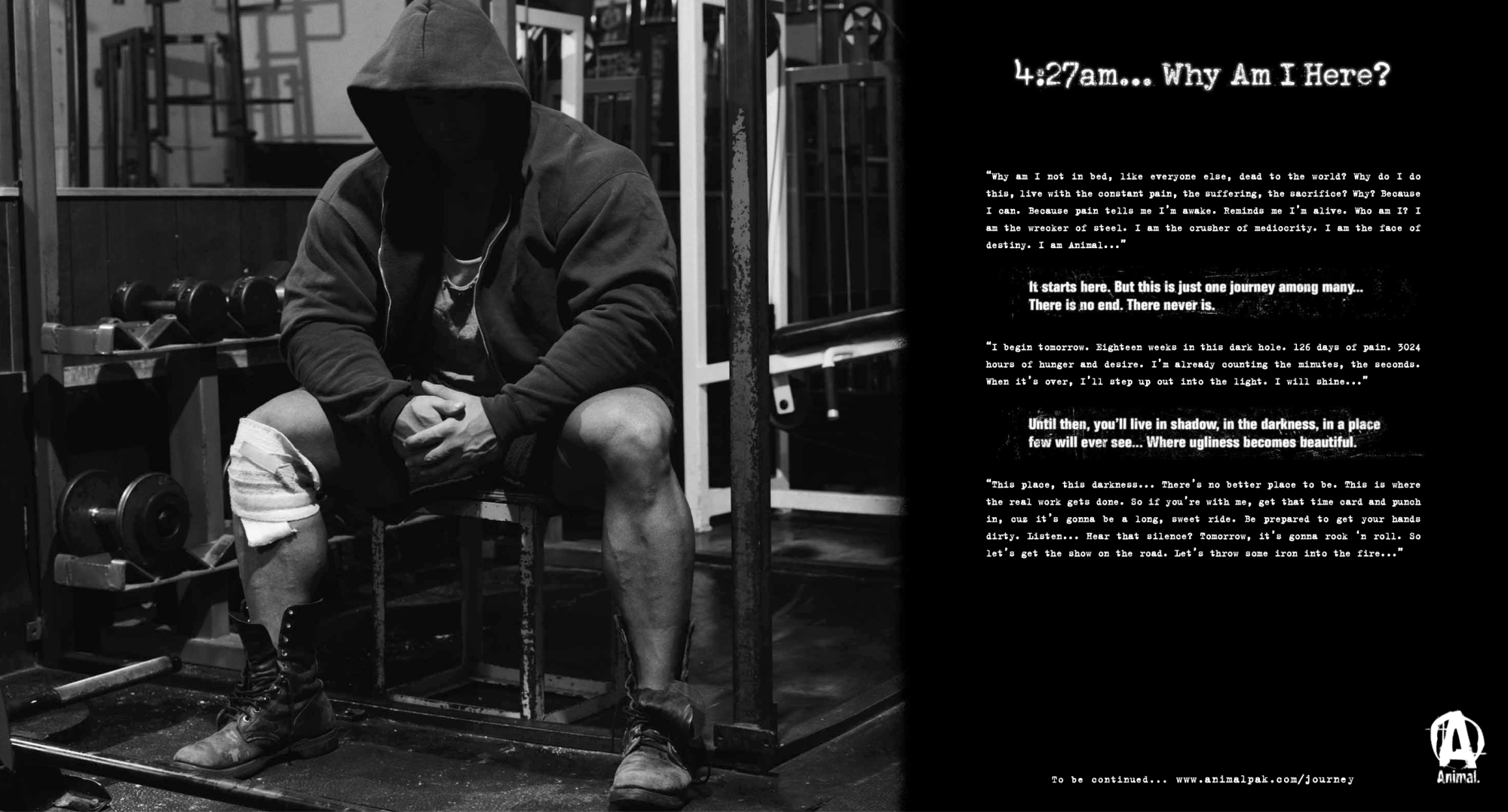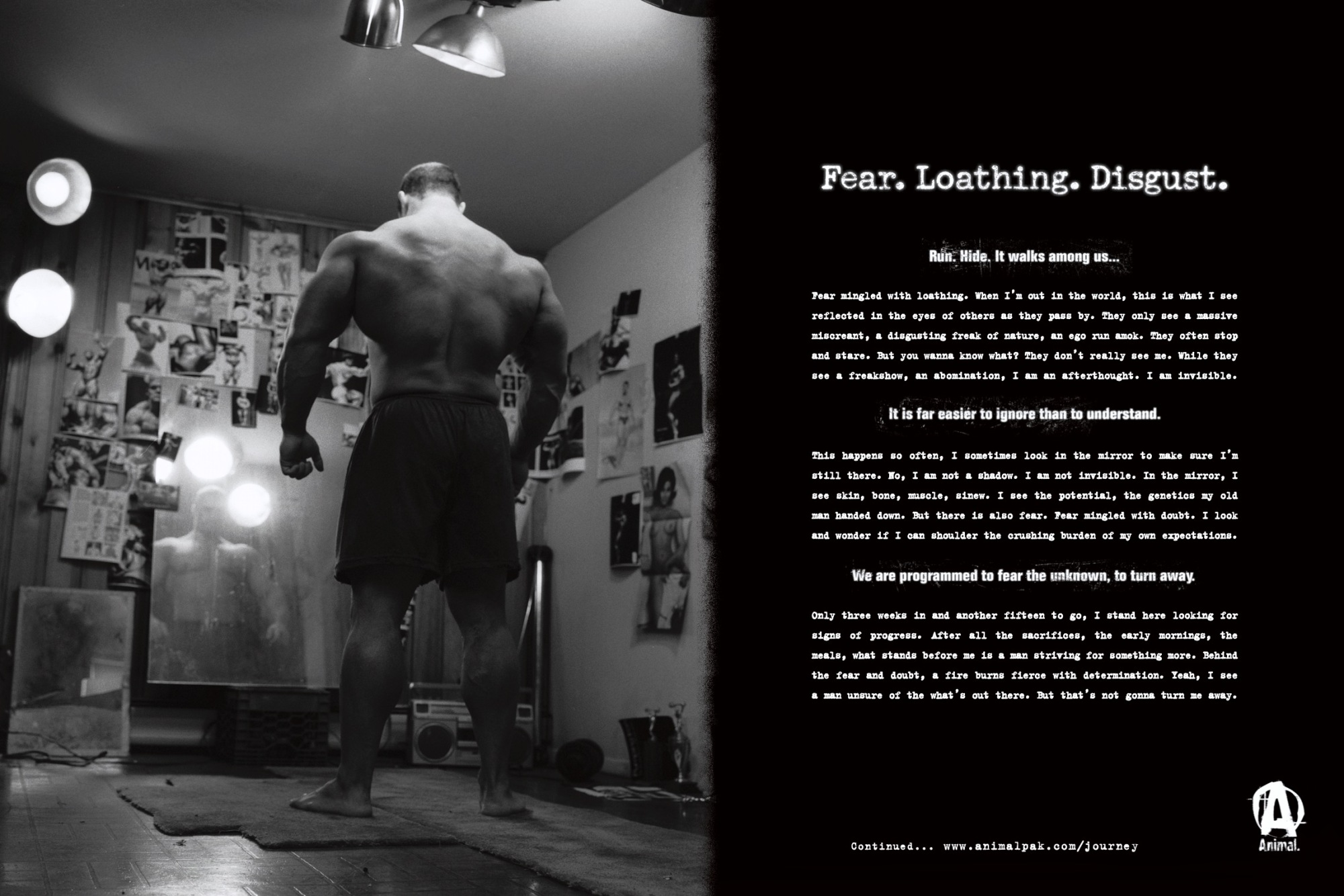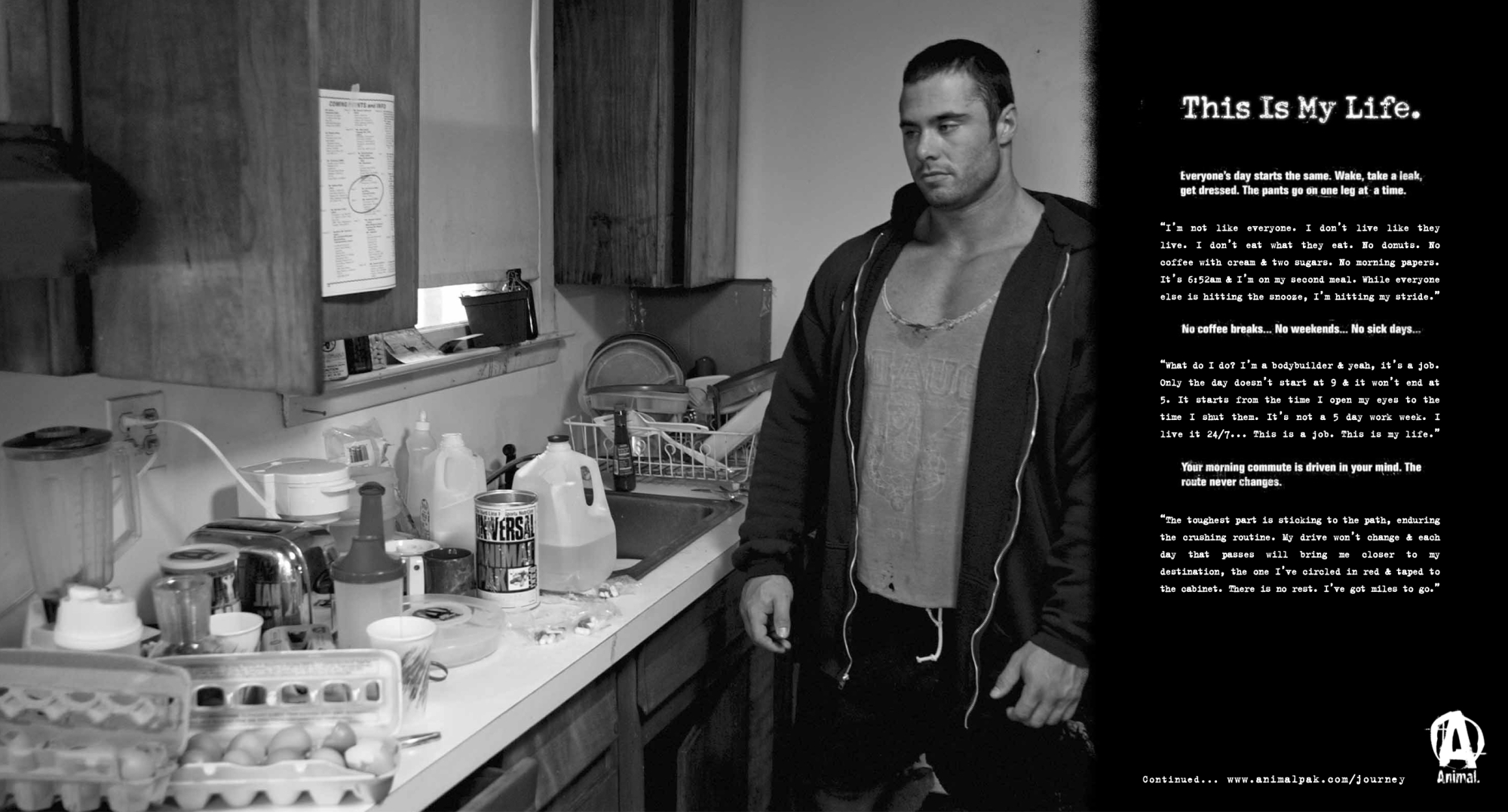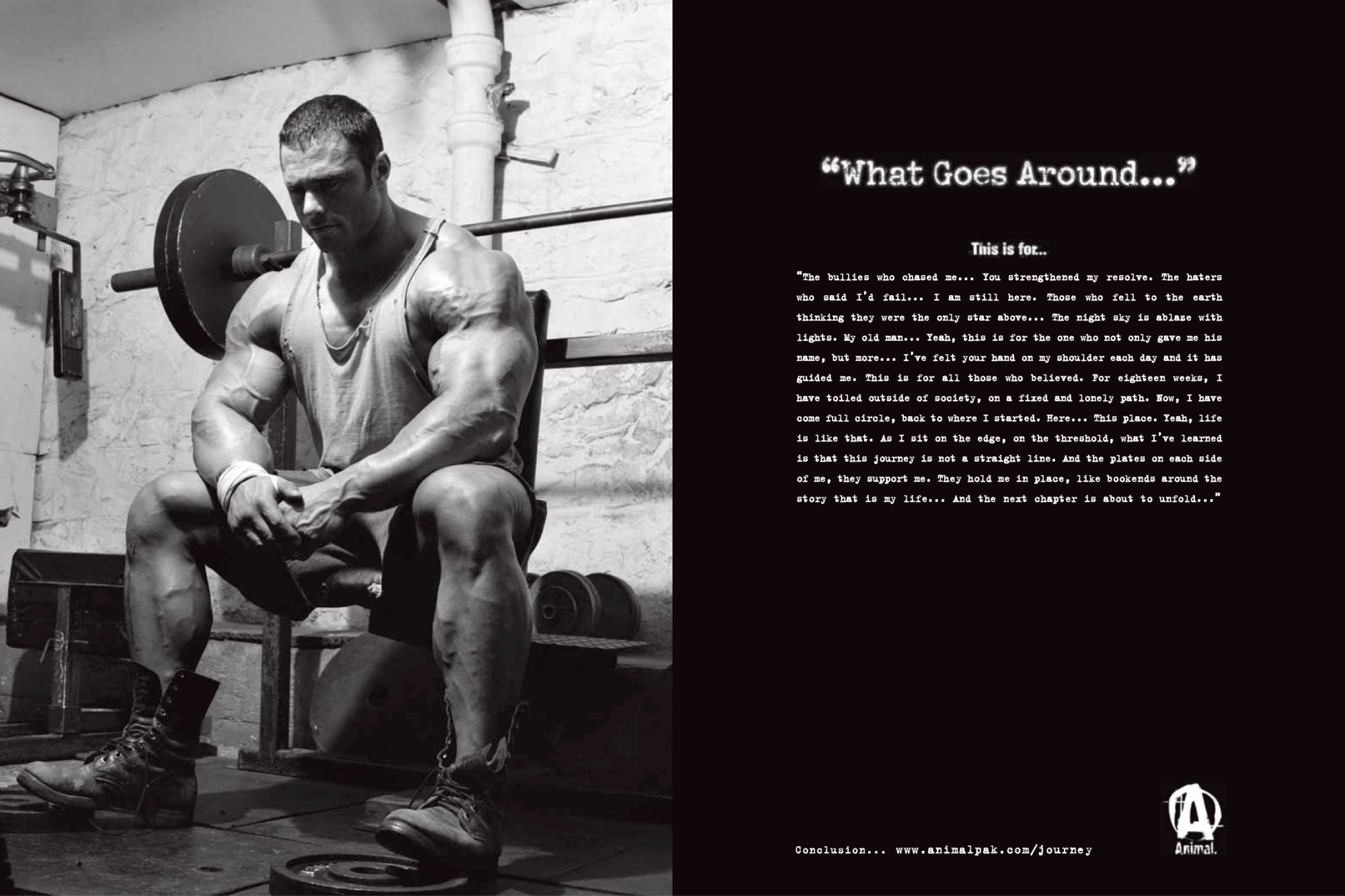"The Journey" was my second advertising campaign, one structured as a narrative and kind of bildungsroman. Each ad functioned like a chapter, progressing the story of Wrath, a bodybuilder preparing for a contest.
In the first campaign, each ad appeared in print only and was a vignette spotlighting a single idea. This time I wanted to tell a story, and built out a campaign in print and online for the first time. We ran eighteen print ads (2-page spreads)–one per month. Online, at a microsite we created specifically for the online portion of the campaign, I provided an additional three ads each week, for a total of fifty-four ads. Taking the print versions into account, in an 18-month span, I wrote the equivalent of 72 entries–more than enough to tell the story of "Wrath," a moniker we gave to a sponsored amateur athlete and relative unknown. This was a particularly rigorous if not grueling project as I felt like I was essentially writing ad copy every day of the week.

Throughout the campaign, there are three voices (as the above below
shows)–first person, emanating from the mind of Wrath himself, and third
person from an omniscient perspective and functioning similar to a
chorus. To add an extra layer of complexity, I also employed
second-person, one which transcended the confines of the story to touch
the reader with the hopes of bringing the consumer into the world I was
creating.

Unlike the first campaign, in Journey, I wanted to plumb greater psychological depths. That meant two things. First, I wanted to know the real person behind Wrath, the character in the campaign. Frank (his real name) and I spent many days just talking. Like a reporter or a biographer, I peppered him with hundreds of questions, recording every word for later use. I wanted Wrath to be as accurate and true-to-life as possible. Why? Because when Wrath/Frank stepped out of the pages of a magazine and into a public space (as he eventually would), I didn't want incongruity that would lessen the impact of the story in the mind of our customers. Rather than limit ourselves to the gym, the locus for all advertising in
our industry, we portrayed the athlete in that other space–his
home.This opened up many new ways to tell a deeper story. In the above
ad, we see Wrath looking at himself in a mirror. The posing mirror, and
the myriad of inspirational photos scattered around it, functioned as a
kind of altar. Eschewing creature comforts, Wrath focused only on the
things that would allow him to reach his goal. If you look carefully,
you'll even see photos from the photographer himself.

If you're going to talk about lifestyle, then you have to talk about "life" in general. Other ads always depicted a highly energized, muscular individual caught perfectly in the moment of hoisting big weights. In real life, we all know there are ups and downs. I wanted to reveal a different world, one not shown in any of the magazines from M&F to Flex. Here, Wrath looks none too happy, knowing that it was time for another meal. Working on this campaign was a ton of fun–it felt like we were working on a set. I remember going back and forth to the local supermarket, to make sure we had the right foods–eggs, steak, and of course Animal Pak.

This is the campaign's penultimate ad above. As with the first ad shown
at the top of this page, we find Wrath, seated in the gym. By coming
full circle in the imagery, I could draw a constrast between the
beginning and end of the campaign. I can draw your attention to two important elements in the photographs here. In the first ad, the camera's perspective is slightly above the athlete, whereas in the one above, the camera was situated slightly below. I think this creates a more powerful image–like a king on a throne. Perhaps more importantly, Wrath is completely visible–the hoodie is gone and the athlete is in the light (foreshadowing his upcoming bodybuilding contest).
• • •
Bringing The Ad Campaign To Life
This campaign was extremely popular and we received a lot of requests for ad posters. Because we had our own in-house Printing Department, cranking them out and mailing them at no cost was easy enough. But we went one step further. We printed a 104-page special edition "Journey" book using thick stock and spiral binding. We sent these to anyone who requested one, free of charge. This book contained all the ads, both print and online, and all in one place. In terms of content, the Animal brand was organized around four major categories: training, eating, living, and of course supplements. For consistency, these categories were used to organize everything from books to website to forum. I believe good brands promote consistency, and consistency breeds familiarity. So in the "Journey" book, you not only got the ads, but you also got various meal plans, training articles, plus a 38-page blank journal for training, diet and general entries. This book was part of our three-prong approach (along with print advertising and web) to getting the story of Wrath and Animal into the hands of current and future fans. If you'd like a digital copy, click here on the
Journey Book.
• • •
ADDITIONAL: I can still remember the time before the campaign started when I pitched
the idea to leadership. Perhaps due to the success of the first
campaign, much criticism may have been blunted. Despite that, some
voiced their doubts that I could tell a story through magazines that
appeared only once a month. But I firmly believed it could be done.
After all, if Charles Dickens and others could successfully publish
their novels in a serialized form in the 19th century, why not an ad
campaign in the 20th? In the end, Journey did more to put
the Animal brand on the map than any other marketing execution prior. It
was (lucky for me), a great success. As with the first ad campaign,
this one won a coveted BBCOM award for best advertising campaign. This
put a lot of pressure on me. What would be next? Could I go to the well
one more time and feature Brian's powerful B/W photos? Or was the brand
ready for a shift? Did customers expect something different, something
new? I knew I had to balance many exigencies. At the same
time, I also knew (though it might seem counterintuitive) that the
smaller you make a brand, the greater its strength. As a marketer, if
you are doing your job right, it can often feel monotonous or even
boring. By this I mean that if we think of brands as people, then like
people, brands can't change their personalities every other month. What
you can vary are the facets (going back to that diamond metaphor). In
short, brands shouldn't change much, and sometimes, only incrementally.
But like people, you can also dress up brands in new fashions that are
transient.
[
To Lifestyle Campaign #3: "
Breach" ]



